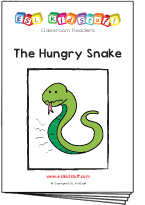Time frequency – “How often …?” lesson plan
Stand-alone lesson ESL kids lesson plan
Lesson plans for ESL kids teachers
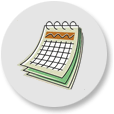
Time frequency – “How often …?”
In this lesson students practice using expressions of time frequency and the present simple tense to say how often they do things. Students practice talking about key dates on a calendar, take part in interviews and play some fun games.
Members get accompanying flashcards and worksheets.
Download materials:
Our lesson plans are FREE!
Sign up for accompanying:
✔ worksheets
✔ homework sheets
✔ craft sheets
✔ flashcards
✔ song downloads & videos
✔ classroom readers & videos
Click to see lesson details, materials and supplies
Time: 40 mins – 1 hour
Objectives: Using the present simple tense to say how often you do things.
Structures: “How often do you …?”, “never”, “once”, “twice”, “(3) times”, “every day”, “a week”, “a month”, “a year”.
Target vocabulary: day, date, week, month, year, calendar, ride a bike, swim, ski, play [hide_on_uk]piano[/hide_on_uk][hide_on_us]the piano[/hide_on_us], play (a sport), do ballet, get a haircut, read a book, eat (steak), take a bath, play a board game, go bowling, go to the [hide_on_uk]movie theatre[/hide_on_uk][hide_on_us]cinema[/hide_on_us], play video games.
Lesson materials
Flashcards:
- ride a bike, swim, ski, play [hide_on_uk]piano[/hide_on_uk][hide_on_us]the piano[/hide_on_us], play (a sport), do ballet , get a haircut, read a book, eat (steak), take a bath, play a board game, go bowling, go to the [hide_on_uk]movie theatre[/hide_on_uk][hide_on_us]cinema[/hide_on_us], play video games.
Printables:
- How often …? (2) Week / Month / Year worksheet
- How often …? (4) Week / Month / Year worksheet
Additional materials:
- How often…? worksheet
Supplies:
- [hide_on_uk]colored[/hide_on_uk][hide_on_us]coloured[/hide_on_us] pencils
- calendars (1 per pair or group of students)
- a ball
- pictures of famous characters (1 for teacher and per pair)
- blank slips of paper (1 piece per student)
- Blu-tack or tape (to stick the character picture to your board)
- board with marker / chalk
- device to play the song on
This lesson will help your students to talk about their lives in terms of frequency. The lesson will cover time-related vocabulary and action verbs, so make sure your students have already completed the dates (ordinal numbers), days of the week, months of the year and basic actions vocabulary.
Time expressions are used to describe how frequently we do certain activities. They are often used in response to the question “How often do you …?”.
Here are some commonly used time expressions:
- never: “I never cook dinner”.
- once, twice, (3) times, etc.: “I play tennis once a week”.
- every day: “I do homework every day“.
- ~ a week: “I play piano 3 times a week“.
- ~ a month: “I go to the gym twice a month“.
- ~ a year: “I ski once a year“.
Time expressions take the following forms:
- never: cannot be used with a time frequency such as “a day / a week / a year”. It goes after the subject and before the verb:
E.g. I (subject) never drive (verb) a car. - once, twice, (3) times, every day: must be used with a time frequency such as “a day / a week / a year / every day”. It goes after the verb. If there is a direct object or indirect object, it goes after that:
E.g. #1 She (subject) sings (verb) every day.
E.g. #2 He (subject) drinks (verb) tea (direct object) 3 times a day.
E.g. #3 I (subject) write (verb) a letter (direct object) to my cousin (indirect object) twice a year.
Lesson procedure:
Warm up and maintenance:
The beginning of your lesson is extremely important: this is where you set the tone of your lesson and get everyone in the right frame of mind for learning English. It is also an opportunity to check homework and review previous lessons.
Click for warm up suggestions for the start of your lessons
These activities can be done in the following order at the start of your lesson:

1. Greetings and name tags
Greet the students by name as they enter the classroom and gesture for them to sit down. Before class prepare some blank name tags (stickers or pin-on tags). Give these out and have everyone write their names and put their tags on. If you use pin-on tags, you can keep and give out every class.

2. Homework check
Check each student’s homework set in the last lesson. Ask each student some questions about their homework worksheet (e.g. “what [hide_on_uk]color[/hide_on_uk][hide_on_us]colour[/hide_on_us] is it?”), give lots of praise, and then put some kind of mark on the homework sheet (e.g. a sticker, a stamp or draw a smiley face). Finally, tell your students to put their homework back into their bags.
3. Review past lessons
Reviewing past lessons is very important – students need constant practice of new vocab, structures, songs, games and so on. Always review parts of your last lesson as well as some parts from other previous lessons. You can spend 5-10 minutes reviewing – it’s fine to recycle games and activities from your past lessons to review as kids enjoy playing familiar games (although be careful not to play a game to death!). See the section “Other ideas to include in your warm” below for ideas.
You can also include review activities in the main body of your lesson. Kids can have short attention spans so it’s good to be able to pull out lots of activities during different stages of the lesson.
Other ideas to include in your warm up:
Ball pass questions
This is good to review questions from previous lessons. Get everybody standing in a circle.
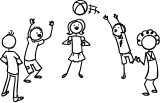
Round 1:
Take a ball and hold it and say, “My name is (you name)”. Then throw the ball to one student and say, “What’s your name?”. Students throw the ball around randomly, saying their names and asking for names.
Round 2:
This time ask a review question, e.g. “How many tables are there?”. Then throw the ball to a student who should answer, “There are (6) tables”. Help if necessary. Then that student throws the ball to another student and asks a “How many …?” question. Continue so everyone has a go. You can have multiple rounds with different topic questions.

Play “Spin the bottle”
Sit students in a circle with a bottle in the middle. Teacher spins the bottle. When it stops spinning the student it is pointing to has to answer a question. If the answer is correct then that student can spin the bottle. This is a good class warm up activity (e.g. How are you? What’s your [hide_on_uk]favorite[/hide_on_uk][hide_on_us]favourite[/hide_on_us] food? How’s the weather today?, etc.

Play “Vocabulary basketball”
This is a fun game which reviews vocabulary from previous lessons. You will need a basket (a trash can) and 2 balls (or 2 pieces of A4 paper scrunched up into balls).
Form 2 teams and line them up so that two players from each team are facing the front with the basket in front of them. Let both players throw their ball – if they get their ball into the basket they can try and win a point by giving the correct answer to a question the teacher asks. This can be an actual question (e.g. What are you wearing?) or a flashcard (What’s this?). Then they go to the back of the line. At the end, the team with the most points is the winner!
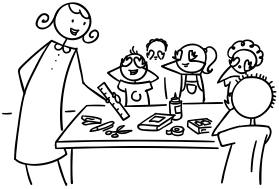
Play “What’s missing?”
This is a fun review memory game – students will have to try to remember review objects from previous lessons (e.g. classroom stationery). Lay the objects out on a table for all to see. Allow the students a minute to memorize the positions of the objects. Remove an object and hold it behind your back. Say, “Open your eyes!” – the first student who can shout out the missing object wins a point for his/her team. Play for all the objects.
Finally, calculate which team has won the most points and give them a round of applause.

Play “Quiz game show”
This is a fun quiz game, like a simple version of a TV game show. Draw some circles on the board and randomly write numbers 1, 2 or 3 in each circle. These will be points.
Put students into teams. Then ask the first team to choose a number – 1 is an easy question (e.g. “Do you like bananas?”) and 3 is a difficult question (e.g. point at a clock and ask, “What time is it?”). 2 will be in between in terms of difficulty. When the question has been answered correctly, erase that number circle. Play until all the number circles are gone – the team with the most points is the winner!
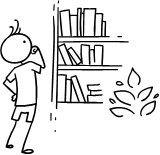
Read a classroom reader again
As you progress through the lessons you will start to build up a catalog of classroom readers (see our Readers download page at https://www.eslkidstuff.com). Kids love going back to old stories and reading through them again. Invite a student to pick a classroom reader and read through it as a class. Make the story as interactive as possible by asking questions (e.g. what [hide_on_uk]colors[/hide_on_uk][hide_on_us]colours[/hide_on_us] there are, the names of different objects, etc.) and getting students to speculate what is going to happen next in the story.

Talk about the weather (do after you have taught the weather lesson plan).
- Prepare a weather board. Before the first class prepare a piece of cardboard and cover it with felt – you are going to pin this to the wall. If you can, try and get blue felt (to represent the sky). Write at the top in large letters, “How’s the weather today?”. Below that write “Today it’s”. Cut out weather pictures (such as our weather flashcards) and stick some velcro on the back. Arrange the weather pictures around the edge of the board and then put the board on the wall of your classroom. You can now use this weather board at the beginning of every lesson.
- Ask about the weather. Ask, “How’s the weather today?” and have students put up their hands. Allow one weather condition per student (e.g. “It’s rainy”) and have each student come up and put a weather picture on the weather board.
- Introduce more weather vocabulary. Depending on weather conditions, you can introduce more weather words (with pictures … you can get students to draw them), such as:
- stormy
- misty
- showery
- freezing
- humid
- frosty
- icy
- drizzly
New learning and practice:
1. Review vocabulary: “Calendar fun”
Your students will be talking about how often they do things using the words “a week”, “a month” and “a year”. They will have already covered these words in previous lessons so this is a fun review activity.
You’ll need a few calendars – depending on how many you can get your hands on, give out one calendar to each pair or group.
To elicit the key vocab, start off by writing on the board:
Today …
- The day is _____________________. (e.g. Wednesday)
- The date is _______________________. (e.g. 12th)
- This month is ____________________. (e.g. March)
- It is the _______________ week of the month. (e.g. 2nd)
- The year is _________________. (e.g. 2024).
Put students in pairs/groups to talk about their answers (using their calendars).
After a couple of minutes, hold up a calendar and ask, “What’s this?”. Elicit “Calendar”.
Then say, “Let’s use the calendar to find the answers”. Then, holding up the calendar show / elicit the answers and complete the blanks on the board.
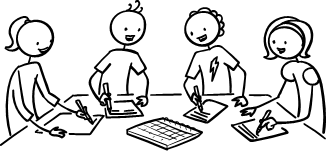
Next, write the following questions on the board and have your students work in their groups with their calendars to find the answers:
- How many months are there in a year?
- How many days are there in August?
- Which month comes before May?
- Which day is November 17th?
- Which months have 30 days?
- Which months have 31 days?
- How many days are there in February?
- Which month comes after October?
- Which day and date is Christmas?
- Which day and date is your birthday?
- Which day and date is the first day of the year?
- Which day and date is it today?
2. Play “Week / Month / Dates buzz”
This is a fun game to practice saying the days of the week, months of the year and dates (ordinal numbers) in sequence.
Get everybody standing in a circle. You need one ball. Start by passing the ball around the circle with students counting numbers as pass the ball (1 .. 2 .. 3 .. 4 .. etc.).
Next, introduce the game “Buzz”. When students pass the ball, every 5th number the person holding the ball must say “Buzz” instead of the number, for example:
1 … 2 … 3 … 4 … BUZZ … 6 … 7 … 8 … 9 … BUZZ … 11 .. 12 … 13 … 14 … BUZZ … 16 … etc.
Start the game – the ball is passed from student to student around the circle with each person counting the numbers as they pass the ball … and saying “Buzz” every 5th number. If anyone makes a mistake the game has to start from 1 again. Try and get the pace going really fast.

After a few rounds change to days of the week instead of numbers, again, saying the word “Buzz” every 5th day:
Monday … Tuesday … Wednesday … Thursday … BUZZ … Saturday … Sunday … Monday … Tuesday … BUZZ … Thursday … etc.
After a few fun rounds change to months of the year and finally dates (ordinal numbers):
January … February … March … April … BUZZ … June … July … August … September … BUZZ … November … December … January … February … BUZZ … April … etc.
1st … 2nd … 3rd … 4th … BUZZ … 6th … 7th … 8th … 9th … BUZZ … 11th … etc.
3. Introduce the structure “How often do you?”
Before class, find a picture of a famous character or person (cut out from a magazine or print out from the Internet – I use Bart Simpson).
a) Hold up the picture and ask some students if they like this character. Then stick the character onto the left-side of the board and write above it “How often do you …?” (see board layout image below).
b) Next, take some flashcards of everyday actions (make sure that your students are already familiar with many of them), such as:
ride a bike, swim, ski, [hide_on_uk]piano[/hide_on_uk][hide_on_us]the piano[/hide_on_us], play (a sport), do ballet , get a haircut, read a book, eat (steak), take a bath, play a board game, go bowling, go to the [hide_on_uk]movie theatre[/hide_on_uk][hide_on_us]cinema[/hide_on_us], play video games
c) Hold up the first flashcard (e.g. ride a bike) and elicit the vocabulary. Then say, “Does (Bart Simpson) ride a bike?”. Elicit, “Yes, he does”.
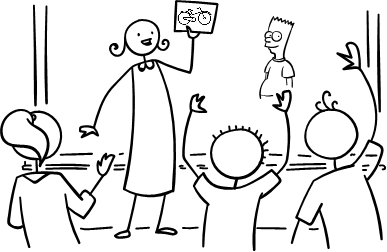
d) On the right-side of the board write:
– 0 = never
– 1 = once
– 2 = twice
– 3 = three time
– 4 = four times
– 5 = five times
– 6 = six times
– 7 days = every day
– a week
– a month
– a year
e) Now write next to the character’s image, “How often do you ride a bike, Bart?”. Turn to the class and by pointing at the numbers on the right-side of the board try to elicit an answer (e.g. every day). For the first couple of questions, you may need to give the answer until your students start to pick up the idea. Say and write the answers (below the picture of the character) … if you can, try to say the answers in the character’s voice (e.g. “I ride a bike every day” in a Bart Simpson voice).
f) Go through all of the flashcards electing the answers and writing the questions and answers on the board – so you should have something like this:
Board layout:

Students can make up any answers they don’t know (e.g. how often Bart has his hair cut) – any logical answer is fine.
As you elect the answers, be sure to point out the word order:
- numbers (e.g. once a week, 6 times a month, every day, etc.) go at the end of the sentence (e.g. I swim twice a week, I ride a bike every day).
- ‘never‘ goes directly after the subject (I never do ballet).
4. Practice the structure “How often do you?”
We’ll do this in three steps:
STEP 1: Controlled speaking practice
Put students in pairs – Student A asks the questions on the board and Student B is the character on the board. Make sure that all Student Bs speak in the character’s voice!
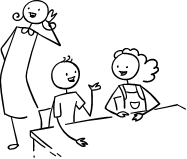
A reads the questions to B and B answers using the sentences on the board. For example:
Student A: How often do you ride a bike, Bart?
Student B: I ride a bike every day.
After all of the questions have been asked and answered students swap roles and practice again.
During this activity the teacher should monitor carefully and help with mistakes and pronunciation. At the end, ask a few of pairs to stand up and demonstrate a question and answer to the class – give lots of praise and a round of applause!

STEP 2: Role play practice
Before class prepare more character pictures (cartoon characters, superheroes, [hide_on_uk]movie[/hide_on_uk][hide_on_us]film[/hide_on_us] stars, TV stars, pop stars, etc.). Make sure you have enough pictures for each pair. Give out one picture per pair. Pairs then practice the questions on the board and giving their own ideas for answers.
After all of the questions have been asked and answered, students swap roles and practice again. When finished, you can have pairs exchange pictures and do again with another character.
Again, the teacher should monitor carefully and help with mistakes and pronunciation. At the end, ask a few of pairs to stand up and demonstrate a question and answer to the class – give lots of praise and a round of applause!
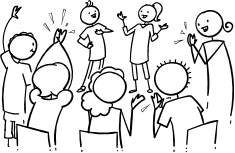
STEP 3: Interview practice
Finally, your students are going to give their own answers to the questions. In pairs, Student A asks the questions on the board to Student B, and student B will answer truthfully about themselves.
After all of the questions have been asked and answered students swap roles and practice again.
As before, the teacher should monitor carefully and help with mistakes and pronunciation. At the end, ask a few of pairs to stand up and demonstrate a question and answer to the class – give lots of praise and a round of applause!
5. Do the “How often …? (2) Week / Month / Year” worksheet
Give out the worksheets and circulate as your students write their answers.
6. Play “Three truths and a lie”
On the board write four sentences about yourself using the time frequency structures but make sure only 3 are true and one is a lie. E.g.
- I cook dinner five times a week.
- I go to the gym three times a month.
- I play golf 5 times a year.
- I never ride a bike.
Tell your students one sentence is not true about yourself and ask everyone to guess which is the lie.
Then give everyone a slip of paper and have them write 4 sentences about themselves, again 3 truths and 1 lie. As they are writing walk around and give help with spelling, etc. Students don’t need to use the same actions from the previous activity – they can write anything they like.
When everyone has finished, get everyone to stand up and find a partner. Tell everyone that they have just 1 minute to read their sentences and guess which is their partner’s lie. Use a timer and shout, “Go!”. After 1 minutes get everyone has to stop and find a new partner, and continue like this for a good few rounds.
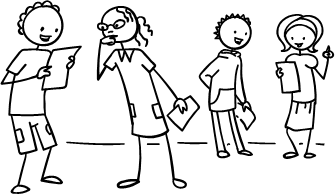
At the end, get everyone to sit down and then ask for some students to tell you some truths about other students.
Wrap up:
Assign homework: “How often …? (4) Week / Month / Year worksheet” worksheet
Click for wrap up suggestions for the end of your lessons

1. Assign homework
Each week give out a homework worksheet for your students to take home. Hold up the homework worksheet and model how to do it. Give out the worksheets and say, “Put your homework in your bags”.

2. Do “Quick check”
Time to leave the class. Make sure everything is put away and the students have gathered their belongings. Have them line up at the door and place yourself between the door and the students. For each student check one new word or phrase, for example:
- hold up an object or flashcard (such as an item of clothing) and ask, “What’s this?”
- ask a question from the lesson (e.g. “Where do you live?”, “Do you like bananas?”, “Can you play chess?”, etc.)
When they give you the correct answer say goodbye and let them leave. If their answer is wrong, have them go back to the end of the line – they will have to try again once they reach the front!
Other lesson plans
Actions, verbs & tenses:
- Can – for ability
- Morning routines
- Daily routines & times of the day
- Actions – Present continuous
- Future plans using “going to”
- Past tense activities – Regular verbs
- Past tense activities – Irregular verbs: Part 1
- Past tense activities – Irregular verbs: Part 2
Adjectives:
- Describing people
- Describing things
- Comparing things (Comparative adjectives)
- Comparing things (Superlative adjectives)
Adverbs:
Alphabet:
Animals:
Body:
Classroom:
Clothes:
Colors:
Colours:
Directions:
Family:
Feelings & emotions:
Food:
Health & sickness:
Holidays & festivals:
Jobs:
Likes, dislikes & favorites:
Likes, dislikes & favourites:
- Likes & dislikes
- [hide_on_uk]Favorites[/hide_on_uk][hide_on_us]Favourites[/hide_on_us] and asking why
Nature & Our world:
Numbers:
Places & where we live:
Prepositions of location:
Pronouns:
Shapes:
Shopping:
Sports:
Time, days, months, seasons:
Toys:
Transport & travel:
Weather:



